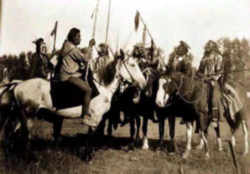


Wisconsin Early History
First Early Inhabitants of Wisconsin

Early history examines the archaeological record that tells the story of the first inhabitants of Wisconsin. Learn about the prehistory and culture of the first early inhabitants, and what lessons it might teach us about the early history of Wisconsin.
Wisconsin First Early Inhabitants Timeline
- 450 Million - A 650- to 700-foot meteorite crashed into the earth at speeds up to 67,500 mph. The impact dislodged rocks and created a massive hole in a 4-mile area called Rock Elm about 70 miles east of Minneapolis, Wisc.
- 12k BCE - Southeast Wisconsin was free of ice by this time.
- 11.5k-10.2k BCE - A site near Kenosha, Wisc., indicates human butchery of wooly mammoths during this period.
- 10,000 years ago - Paleo-indians came through Wisconsin hunting wooly mammoth, mastodon, and bison.
- 7000 BC - 1000 BC - Archaic Period of Native American hunter-gatherer culture as Indians built temporary dwellings, added shellfish to their diets, and fashioned spear throwers to hunt small game.
- c1000 -Dan Arnold, an amateur archeologist, found Indian charcoal drawings in a cave near La Crosse in 1998 that dated back at least 1000 years. The site was not revealed to the public until 2000 to allow official documentation.
- 300 BC - 1000 AD - Woodland Period of permanent houses, embellished pottery, bows and arrows, and maize and squash cultivation.
- 1000 - Mississippian Culture established. This was the last of the mound-building cultures of North America in Midwestern, Eastern, and Southeastern United States
- 1634 - Jean Nicolet was the first known European to reach Wisconsin in search of the Northwest Passage.
- 1679 - Frenchman Daniel Greysolon, Sieur du Luth (1636–1710) claims the region for France
Early History of Native Americans in Wisconsin
The Indigenous People of Wisconsin
The names of the Wisconsin tribes included the Chippewa, Dakota Sioux, Fox, Huron, Iowa, Kickapoo, Mohican, Miami, Munsee, Iroquois, Otoe, Ottawa, Potawatomi, Tionontati and Winnebago.
As long ago as 10,000 years ago, Paleo-indians came through Wisconsin hunting wooly mammoth, mastodon, and bison. After the retreat of the glaciers,
the climate improved and people began to live in caves, along rivers, and around lakes. They hunted smaller animals like deer and elk, and harvested
wild plants, nuts, and acorns. During the Woodland Period, around 3,000 years ago, people began to live together in villages, and use bows and arrows
to hunt. They built burial mounds for their dead.
By the 17th century, the people living in Wisconsin belonged to broad groups of Indians, classified by language type. The Menominee, the Kickapoo and
the Miami tribes spoke Algonquian, and the Winnebago, Dakota and Iowa tribes spoke Sioux. Later in the century, other groups entered Wisconsin including
the Fox, Sac, Potawatomi and Ojibewa (Chippewa).
When the first Europeans came into the area, they brought important opportunities for trade, particularly in furs like beaver. They also brought diseases
for which the native people did not have natural immunities. Many of the native people died from smallpox, measles and mumps. In fact, disease is likely
to have killed many more Native Americans than armed conflicts did. By 1825, the US government and Indian representatives met in Prairie Du Chien and
signed a treaty establishing the boundaries amongst various tribes and opening the way for further non-Indian settlement. However, this treaty did
not prevent further conflict between Native Americans and European settlers looking for land. The native people were eventually forced off their land
to land further west or to reservations.





